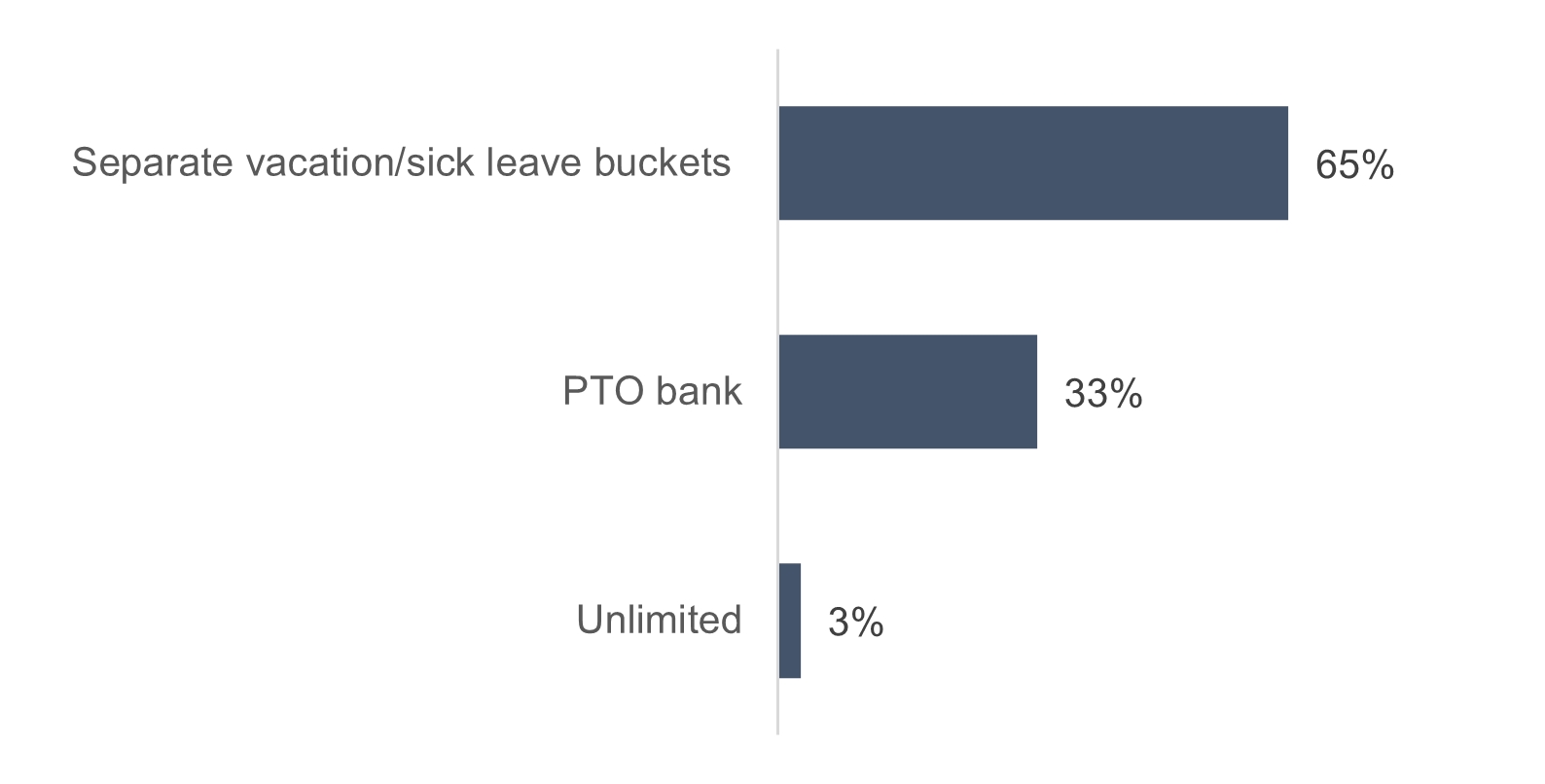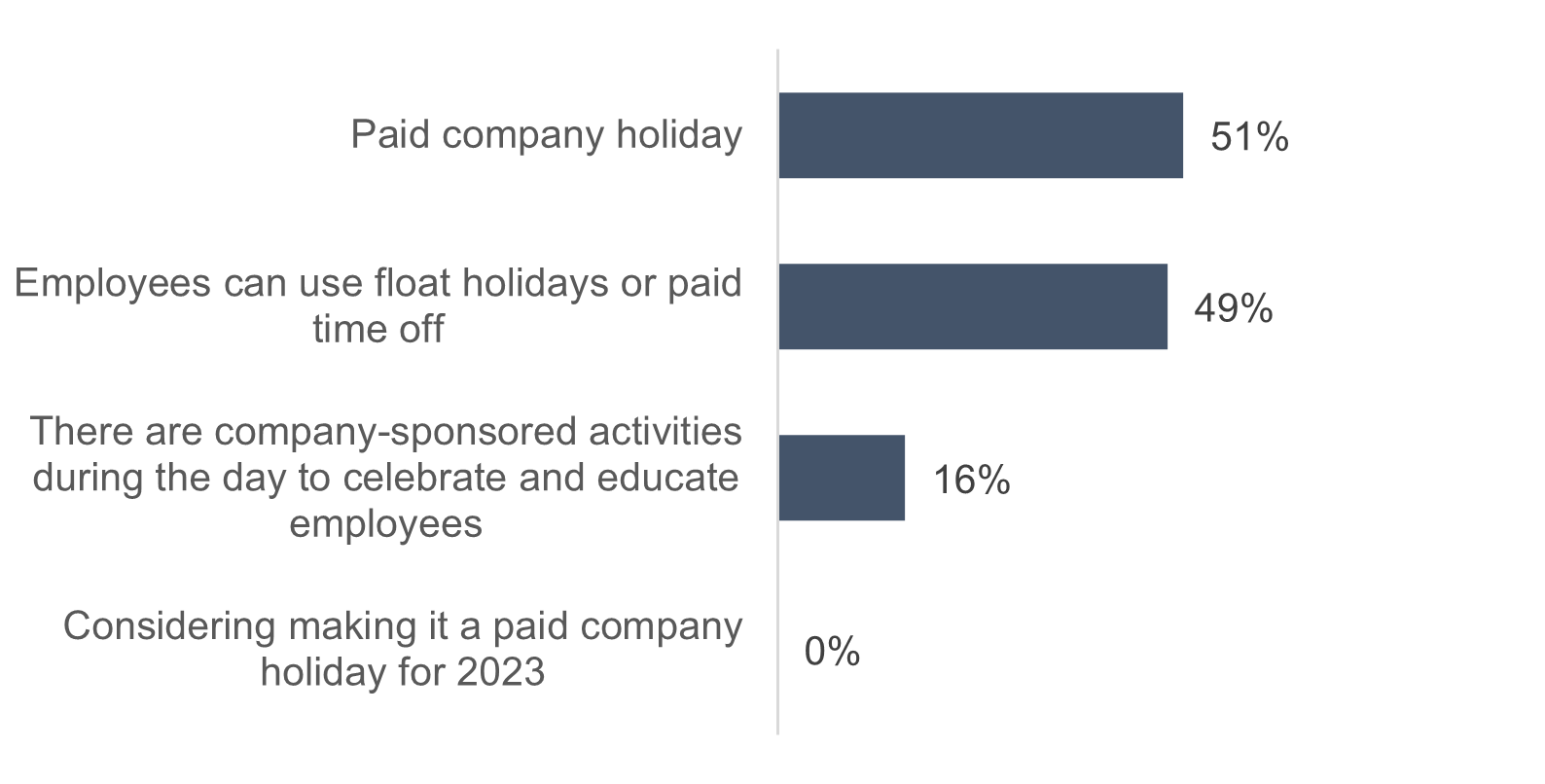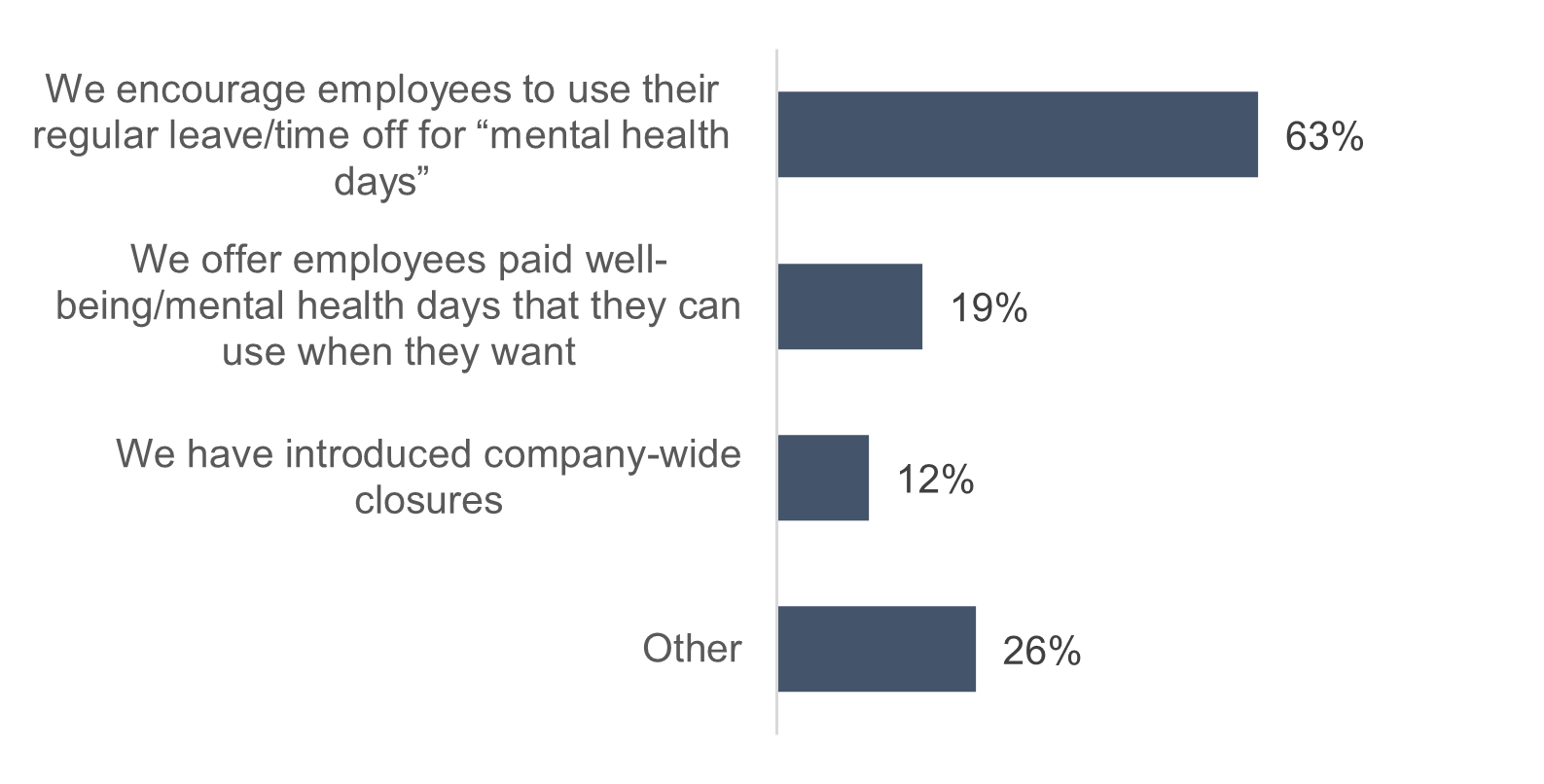November 30, 2022
In acknowledging the vital role time away plays in employee well-being, employers across 11 different industry benchmarking groups convened to discuss important topics such as caregiver leave, paid holidays, mental health days and flexible scheduling.
 Equity in Holidays and Leave Approaches
Equity in Holidays and Leave Approaches
In general, employer members across all industry benchmarking groups are proactively considering the role diversity, equity and inclusion (DEI) will play as it pertains to holiday offerings and leave approaches implemented for the majority of their workforce.
|
Separate vacation/sick leave buckets: Most large employers polled throughout this call series indicated they are using a separate vacation/sick leave approach for the majority of their workforce (Figure 1). Four employers in the pharmaceutical/biotech/medical products industry benchmarking group have separate vacation/sick leave buckets in place for most of their employee population. |

Note: These results are based on the responses of 40 companies across 11 different industry groups.
- Unlimited time off: While this model has existed for a while, the unlimited time off approach has not been widely adopted, but this trend may be shifting as talent retention and recruitment are increasingly top of mind for employer members. As such, unlimited time off policies are being considered and implemented more frequently for certain industries and workforce populations.
- PTO bank: For employers that currently have a PTO bank in place, some mentioned they are experiencing challenges regarding statutory compliance requirements. As a result, they are considering adjusting approaches.
|
In the health care industry benchmarking group, one employer during the call shared that it offers unlimited paid time off (PTO) to leadership team members. |
|
|
Given the already generous PTO programs the pharmaceutical/biotech/medical products benchmarking group has in place, none of the employers during this discussion shared they currently offer unlimited programs—though some are considering doing so for executives. In addition, one member on the call noted there may be research to suggest that an unlimited approach ultimately results in fewer PTO hours taken. |
|
One employer in the pharmaceutical/biotech/medical products industry group who currently has a PTO bank in place shared that due to state compliance challenges, it is considering shifting back to two separate buckets. |
|
|
Discretionary time off: An employer in the manufacturing industry group shared that it is moving from having a PTO bank to an unlimited time off approach—referring to it as discretionary time off (DTO)— for its executive staff starting January 1, 2023. However, this initiative is taking considerably more effort (e.g., coordinating with disability teams) than initially expected. In comparison, another employer on this call is experiencing similar challenges implementing its DTO policy, so it is now working to convince its leadership team to move more toward a vacation and sick time policy approach instead of DTO. |
|
|
Juneteenth: Poll results reveal that across the 11 different industry calls, over half of employers indicated they recognize Juneteenth as a paid company holiday (Figure 2). Most employers did not specify whether adding Juneteenth as a paid holiday replaced a holiday or if the number of paid holidays increased. However, one employer on the technology benchmarking call specified that it did not take away any other holidays when Juneteenth was added, increasing its benefit from 12 to 13 total holidays. |

Note: These results are based on the responses of 37 companies across 11 different industry groups.
|
Employee choice holiday: One employer in the manufacturing industry decided to designate 1 day as an “employee choice holiday,” along with 1 floating holiday and 8 calendar holidays. This employer explained this framing was intentional so employees could feel empowered to take off any holiday of their choice (e.g., Juneteenth, Veterans Day). |
|
|
Differentiated holiday pay to ensure staffing: For members in the transportation and shipping group, the holiday season is often their busiest time of year. Therefore, they tend to offer fewer paid holidays than other industries. One employer shared a benefit of paid holidays from a staffing perspective: Employees who work on a holiday receive a pay differential, which provides the needed incentives to report to work (instead of calling out) when the company needs them the most. |
 Caregiver/Family Leave
Caregiver/Family Leave
Another area employers are examining from an equity standpoint is caregiver and family leave. Employers from each industry group shared information about their caregiver and/or family leave program structure(s). Moreover, employers provided background on how their caregiver/family leave programs have been structured in the past and how that may change in the future to accommodate changing employee needs.
|
To be inclusive of all types of parents, one employer in the manufacturing group expanded eligibility to allow all parents to take family leave regardless of how the family is formed (i.e., non-birth and/or same-sex adoptive parents).
|
|
|
An employer in the pharmaceutical/biotech/medical products industry reported that its caregiver/family leave structure allows 10 days of continuous leave, which includes care for domestic partners or children of domestic partners. This employer indicated that it plans to change this policy in 2023 to allow for two 1-week incremental periods to care for family members for flexibility of use.
|
|
|
Two employers in the manufacturing industry benchmarking group offer 80 hours of paid family medical leave. |
|
|
Numerous large employers across several different industries are considering changing their leave structure to better support employees caring for adult family members. One employer in the manufacturing industry group is currently assessing the value proposition to decide whether to add a separate caregiver leave program or simply rebrand their existing family leave option to highlight how it can be used specifically for caregiving. |
 Sabbaticals
Sabbaticals
Overall, sabbaticals are a growing topic of discussion among some industry groups, with varying levels of consideration, implementation and utilization between different industries and workforce sectors.
|
Tenure-based sabbaticals: Among the handful of employers who shared that they do offer sabbaticals (both paid and unpaid), most do so based on employee tenure. Some also offer sabbaticals exclusively for executive team members, though notably, many are also rethinking ways to improve upon this approach from an equity-based perspective. |
|
|
Paid sabbaticals: In the technology industry benchmarking group, several member companies have considered offering paid sabbaticals, and one employer in this group offers 30 days of paid sabbatical. Employers suggest that employees use the time for educational purposes, but in reality, the sabbatical can be used in a variety of ways (e.g., sending a dependent off to college). This employer further noted that in order for an employee to be eligible, they must have a performance rating that is at least “in the middle of the road.” |
|
|
Industry- and team-specific: There was generally less consideration of paid sabbaticals by employer members in the transportation and shipping or the manufacturing industry benchmarking groups in contrast to others, such as those in the technology industry. In addition, employers with high employee headcounts of certain workforce populations, such as frontline workers, supply chain/operations team members, health care providers and other highly skilled/specialized employees, appear less likely to offer a sabbatical given the nature of their work. |
|
|
Personal leave: Several large employers shared that while they currently do not offer any sabbatical programs, they do provide personal leave. |
 Mental Health Days or Closures
Mental Health Days or Closures
Employers across all industry groups reaffirmed their ongoing commitment to supporting employee mental health through a number of initiatives—including reframing current benefit offerings and providing paid mental health days or closures for employees to recharge and disconnect (Figure 3).

Note: These results are based on the responses of 43 companies across 11 different industry groups.
|
Personal wellness time: In the technology industry group, one employer thoughtfully rebranded its time away offerings (i.e., sick time, holidays and mental wellness days) into an all-encompassing category known as “personal wellness time.” While use of personal wellness time requires managerial approval, this employer purposefully communicated that personal wellness time is defined by the team member themselves and not by the HR/Benefits team, an approach used to encourage utilization. |
|
|
Updated policy language: Two employers in the manufacturing industry group shared that their preexisting policy on the use of sick leave for mental health purposes was unclear. To ameliorate this problem, both employers updated language in their policies to explicitly clarify that mental health is an appropriate reason for using available sick leave. |
 Flexible Work Arrangements
Flexible Work Arrangements
Even as pandemic-related precautions wind down, many employers across all industries recognized flexible work arrangements and continued to prioritize them where possible—not only as a powerful employee attraction and retention tool, but as a means to improve work/life balance and counteract employee burnout as well.
|
In-person incentives: In an effort to encourage employees to return to the worksite, one employer in the pharmaceutical/biotech/medical products industry group provides incentives for employees who return. These incentives include reducing the cost of parking, offering shuttle services and providing breakfast. This employer further noted that it is still operating in a hybrid model (i.e., 3 days in person, 2 days remote) but is working toward returning fully to the worksite. |
|
|
Site-specific/local adjustments: During the consumer products industry group benchmarking call, one employer shared that it allows additional flexibility for employees at certain worksite locations if culturally relevant, such as for hunting season in a specific location. The company explained that this site-specific adjustment is not the norm but rather a local exception to give employees more flexibility on what time they arrive at the worksite. |
|
|
Industry-specific considerations: For employers in certain industries (e.g., transportation and shipping, manufacturing), increasing schedule flexibility can be a challenge for operational reasons. Nevertheless, employer members are considering ways to do so under the post-pandemic reality that provided increased flexibility for workers in many other industry sectors. |
Conclusion
Insights shared throughout this industry-wide benchmarking call series revealed greater understanding about how time away approaches are implemented by members in efforts to improve employee health and well-being along with their overall experience. And when considering the current macroeconomic environment, it is incumbent for large employers to continue to enhance leave, schedule flexibility and time away approaches as a tool for long-term retention alongside other benefits and workforce strategies. What’s more, when thinking from an inclusive and equity-based perspective, leading employers will also take into account the different needs of certain employee subpopulations and adjust their time away approaches and communications plans accordingly.
More Topics
Leave & Flexible Work Arrangements
This content is for members only. Already a member?
Login
![]()
